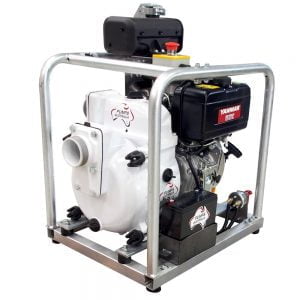What is a self priming pump?
Self priming pumps are a type of centrifugal pump that is able to self-prime before performing the pump job.
Priming refers to the air-water preparation process the pump needs before operating. The process involves the casing to be filled with the liquid the pump will be pumping then, the liquid is pushed up the pipe which forces all of the air through the line and into the pump. It’s this mixture of the air and the water in the casing that expels the air and prepares the pump equipment for operation.
There are both non self priming and self priming pumps, each important for different jobs.

When do you need self priming pumps?
Priming needs to be done each time you use your pump equipment. If you’ve turned your pump equipment off for some time and need to start it up again, priming will need to occur. Whether this is self priming or manual will depend on the pump equipment.
Priming a centrifugal pump can be a difficult task and therefore self priming pumps are becoming more and more popular. Self-priming centrifugal pumps can often self prime even when the tank is not filled with water however, won’t function without water in the tank.
Pros of self priming pumps
Self priming pumps come with a long-list of benefits, such as:
- Efficient pump equipment systems that removes the manual priming responsibilities.
- Reliable self-priming features.
- Tough and durable systems that can handle solids, with some able to handle solids up to 3 inches.
- Self-priming pumps are able to keep on pumping even in situations when the pump equipment is exposed out of the pit.
- Cost effective in the long-term with less infrastructure and maintenance costs.
- Safer option for particular jobs.
- Easier to maintain than non self priming pumps.
- Easy to troubleshoot if error arises.
Cons of self priming pumps
Although self priming pumps come with many benefits, there are a few drawbacks:
- Self priming pumps are often limited in their suction.
- A single pump has a limited flow rate.
- More expensive initially.
Self priming VS. non self priming pumps
Self priming pumps are necessary if a pump has to be located above the level of the liquid to be pumped. Common uses of self priming pumps include: sump emptying, fire fighting, water management jobs, across the mining industry, for effluent and sewage processing and with various wastewater applications within the agricultural industry.
If you’re unsure whether to choose self priming or non self priming pump equipment, talk with our team at Pumps Australia for expert advice. We understand self priming pumps are usually the most ideal pump equipment however, involve a greater initial cost. To make sure you’re spending your money wisely, consult with our Pumps Australia team.
-

Nitro50 Hydraulic
$2,655.95 (Inc. GST) Select options This product has multiple variants. The options may be chosen on the product page -

HP10 GX35 Honda – 1″ Transfer Pump
$764.50 – $979.00 (Inc. GST) Select options This product has multiple variants. The options may be chosen on the product page -

RX80T L100 Yanmar – 3″ Trash Pump
Read more -

WP15 GX200 Honda – 1.5″ Transfer Pump
$1,119.25 – $1,990.45 (Inc. GST) Select options This product has multiple variants. The options may be chosen on the product page



